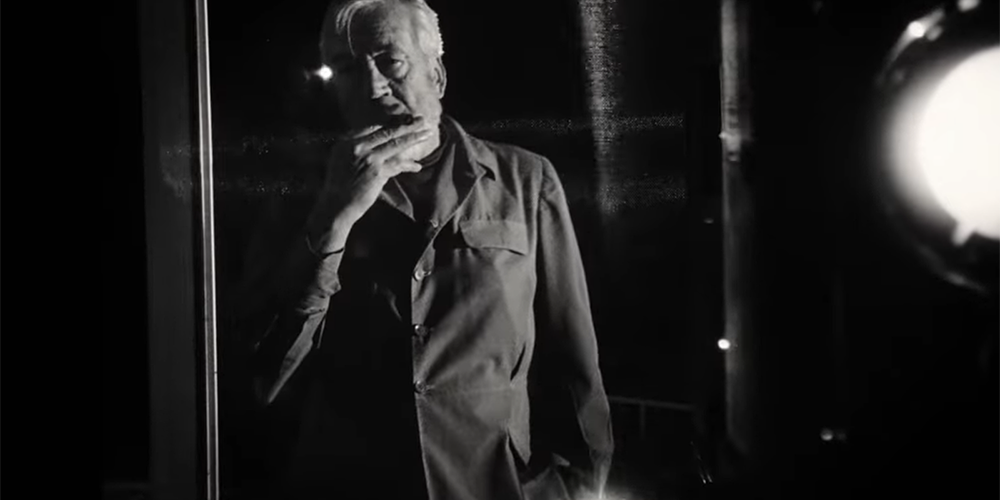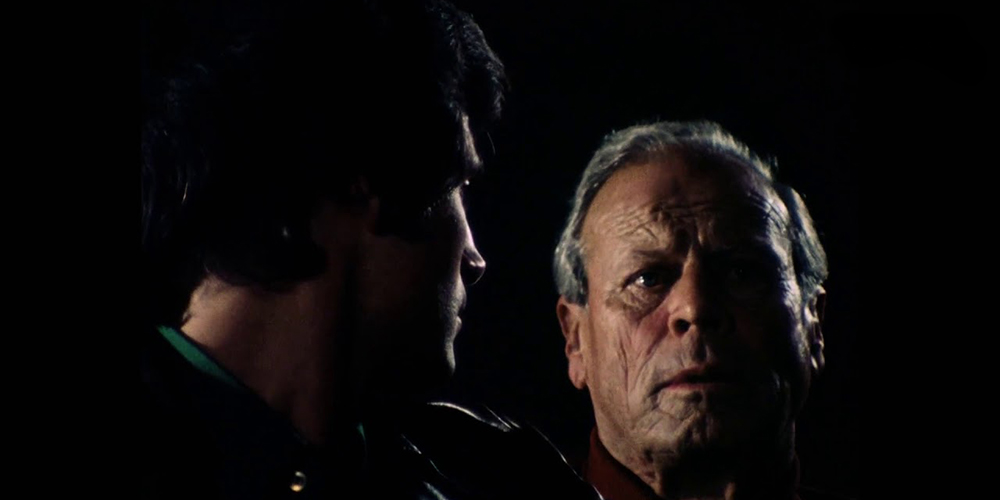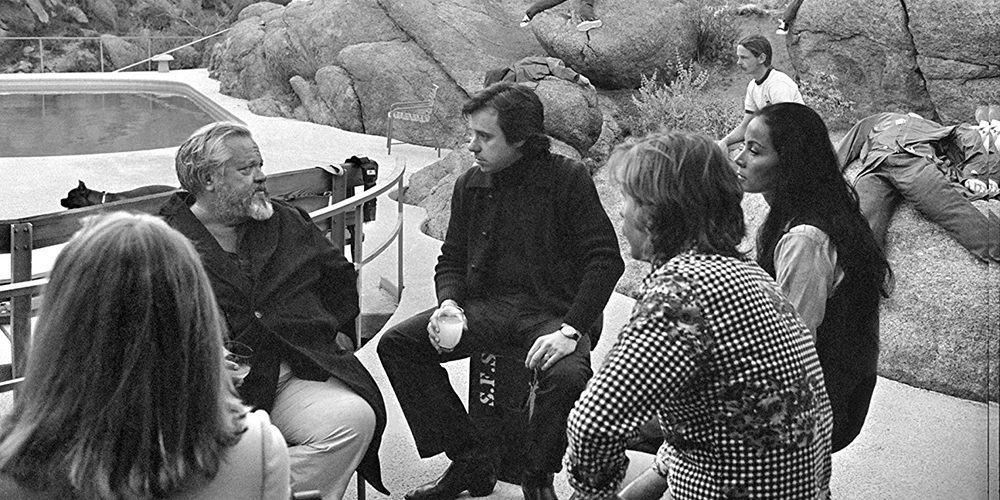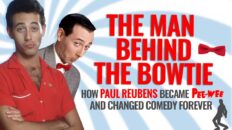This piece was originally published on contributor Ryan Holt’s culture blog, Caves of Altamira.
At long last, Orson Welles’ much-discussed The Other Side of the Wind has been completed and is now available to the world.“I’d call him a necromancer. But I do not know if he’s raised the dead.”
Wind languished for decades since the time of its troubled production, and, by the time of his death, Welles was only able to edit roughly forty percent of the film, some of which was presented as a showreel to potential investors. The money to finish the film never came and decades of legal battles over the rights prevented the film’s completion at the hands of Welles’ original collaborators. Now, not only has a full reconstruction of the film has been assembled, but you can stream the bewildering result right into your living room via Netflix. Until now, an Orson Welles film has never received such widespread distribution.
The Other Side of the Wind tells a quasi-autobiographical tale about a Hemingway-esque director’s spectacular burnout. That director, Jake Hannaford (played with scene-chewing gusto by John Huston), has spun wildly out of control due to his obsession with the film’s leading man, driving him off of the picture and leaving the production in a state of disarray. The picture itself unfolds over the course of a mad, drunken party, during which segments of the uncompleted film are exhibited by Hannaford and his production team. A host of critics and cinephiles have also been invited to the bash with the agreement that they can film the entire event. Welles’ film unfolds as a fictional documentary, prefiguring the “found footage” movement that would arrive many decades later.

The power of art is intimately tied to the way in which it functions as a vessel for psychic forces, and The Other Side of the Wind is all psychic force, so much so that the vessel itself shatters. The Other Side of the Wind is a film about implosion, both in its subject matter and its broader metafictional resonances. It’s an unfinished movie about an unfinished movie, a nexus point where Welles’ life and film work collide, intermingle, and then spin off into the shadows.
The mysteries and contradictions of the human mind loom large in Welles’ career, and though the films could not be texturally more different, the way Wind gestures back to Citizen Kane cannot be denied. In The Other Side of the Wind, art itself becomes Rosebud, at once revelatory and utterly irrelevant. Hannaford’s uncompleted film is a carcass which critics and biographers tear at like vultures. But in its eroticism, its unfulfilled desire, its fixation on the gulf between age and youth, Wind extends more directly from The Immortal Story, with both films pivoting around similar bedroom encounters.
The Other Side of the Wind ultimately reveals itself as a story of stunted, curdled romance. The film sketches out the details of Hannaford’s fraught relationship with his leading man, John Dale (Robert Random), in dialogue, but the emotional force of Hannaford’s obsession with and repressed desire for his leading man can only be discerned within the fragmented scenes of the film-within-a-film. Hannaford’s would-be comeback film, which shares the name of the Welles’ film in which it appears, begins as an absurdly exaggerated bit of artistic pretension, skewering the kind of arthouse stunt-cinema that Welles so disdained. The vacuous, albeit colorful, theatrics gradually give way to a more and more personal expression of desire. Hannaford’s film is a bad movie that becomes a potent one only as it spirals ever further out of control, becoming a more and more honest and vital expression of its author’s repressed desires. The film is Hannaford’s confession, and, finally, his suicide note.

The film within the film contains most of The Other Side of the Wind‘s Welles-edited footage, so it crackles with an energy and fluidity that the rest of the picture cannot quite match. Welles’ editing language was a kind of alien tongue, a pulsing of pure instinct which cannot be recreated. While Bob Murawski, who was tasked with editing together the reams of footage into a film, does a more than admirable job, Murawski is also tasked with attempting to adhere to Welles’ original blueprints in a way that Welles himself would not have been had he been able to finish the picture. We can only speculate as to what impressionistic montages Welles would have produced from Wind‘s raw material. Much of Wind feels like the approximation that it is, and, being an approximation, it tends to magnify the limitations of Wind‘s structural components.
The Other Side of the Wind may be Welles’ most structurally intricate narrative picture, though, in broad strokes, it follows a format he utilized in earlier works. Like Kane and Arkadin, Wind is essentially comprised of a series of interviews and exchanges about a mythic male figure, but here all these moments are layered on top of one another. It’s often a thrilling effect, but in order to anchor the cacophony, the big dramatic pivots have all the subtlety of a sledgehammer. Bluntness and obviousness are not necessarily artistic sins, but whatever nuance or embellishment that Welles’ editing might have granted to this often broadly drawn material is a matter of pure speculation.

What emotional heft the film carries comes from its grace notes, those fleeting moments where, amidst the chaos, the veneers crack. Welles seems to wield Huston mostly as effect, a growling, demonic presence steeped in booze, but in moments where Hannaford’s dependence on those around him comes into focus (a dependence Hannaford greatly resents), the sadness of his existence shines through. His scenes with his great acolyte, Otterlake–portrayed by Peter Bogdanovich in a very self-effacing turn–are the closest the film comes to tenderness.
The jazz-infused score by the venerable Michel Legrand, who worked with Welles on F for Fake, locates and develops the existential momentum in the fragmented material, swinging along with the film as it shifts from despair to delirium. Of all the film’s elements, Legrand’s score feels the most complete, a gift from one of film’s greatest composers to one of film’s greatest directors.
At one point in the film, a character remarks that “no machine ever produces as much as it consumes,” a line that summarizes Wind‘s Hannaford and the carnivorous film industry he inhabits, but also plays as a bitter confession from Welles himself. In The Other Side of the Wind, Welles mined his own hardships and sorrows for drama, and ultimately the story he told in The Other Side of the Wind became a self-fulfilling prophecy, a hazy portrait of Welles’ self-destructive impulses that was derailed by those same impulses.








